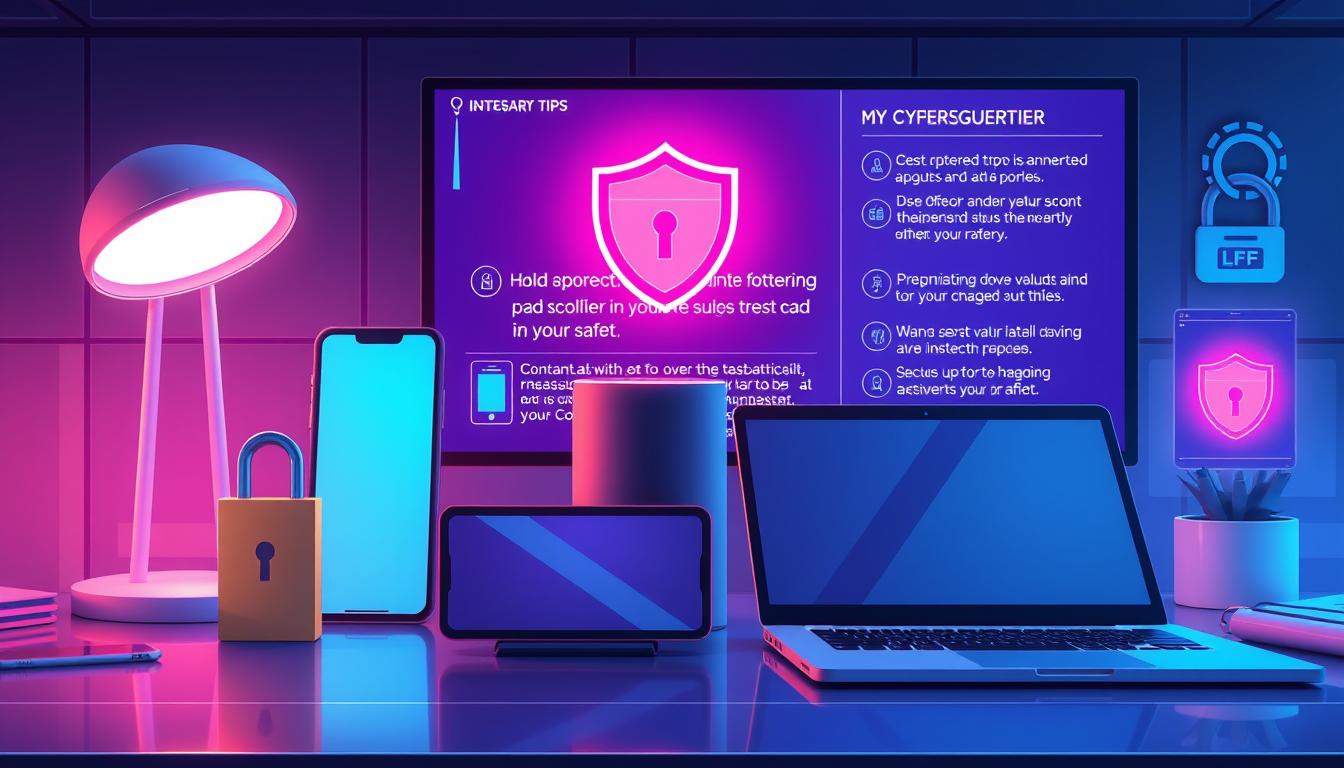There are 131 ways to boost your online safety for free1. It’s vital to follow smart device safe practices in today’s digital world. By using smart devices wisely and keeping smartphones safe, you can lower cyber attack risks. For more on cyber hygiene, check out cyber hygiene daily habits.
Updating apps regularly can stop 85% of targeted attacks1. This shows how key software updates are in stopping cyber breaches. By focusing on safe device use, you can safeguard your data and avoid financial losses from cyber attacks.
Key Takeaways
- Implementing smart device safe practices can reduce the risk of cyber attacks
- Regular software updates are key in stopping cyber breaches
- Using strong, unique passwords and enabling 2-Factor Authentication (2FA) can protect sensitive accounts
- Being careful with public charging stations and avoiding suspicious emails can stop malware infections
- Monitoring email activity logs and keeping antivirus software up-to-date can help spot and stop unauthorized access
- Good cyber hygiene can cut cyber incident risks by up to 80%2
- Keeping a tape over laptop cameras can help avoid risks from malware that might turn on the camera for spying2
Understanding Smart Device Security Fundamentals
With over 30 billion connected IoT devices by late 20233, it’s key to grasp the security risks they bring. Learning how to keep devices safe and secure is vital. This is because 61% of businesses with IoT devices have faced cyber attacks3.
Smart devices face threats like malware, unauthorized access, and data breaches. Studies show that 75% of organizations see IoT devices as a data breach risk3. To fight these risks, using strong passwords and keeping software updated are effective. These actions can cut down risks significantly3.
Why Traditional Security Measures Aren’t Enough
Firewalls and antivirus software alone can’t protect smart devices. Many IoT devices have weaknesses that hackers can exploit. About 70% of IoT devices have vulnerabilities that can be used without proper security3. So, it’s important to add extra security steps like encryption and network segmentation.
The Impact of Poor Device Security
Poor security can lead to data breaches, financial loss, and harm to reputation. By 2025, businesses will spend over $1 trillion on IoT security3. Understanding threats and taking steps to protect devices is critical. This way, individuals and businesses can lower cyber-attack risks and keep their devices safe.
| Security Measure | Effectiveness |
|---|---|
| Strong Password Policies | Up to 90% reduction in unauthorized access risks3 |
| Regular Software Updates | 63% reduction in vulnerability to attacks3 |
| Encryption | Essential for protecting sensitive information4 |
Essential Smart Device Safe Practices for Daily Use
It’s vital to have safe internet habits in today’s world. Cyber threats are getting more common. Using strong encryption like WPA2 can make Wi-Fi safer5. Also, two-factor authentication (2FA) helps block unauthorized access by sending a code to your phone5.
For better smart device security tips, check your IoT devices often. Use strong passwords, update software, and avoid suspicious links or attachments. About 60% of data breaches are due to weak passwords, says Verizon’s Data Breach Investigations Report6. These steps help keep your devices safe from cyber threats.
Some important smart device security tips are:
- Use strong, unique passwords for all accounts
- Turn on two-factor authentication (2FA) when you can
- Keep your software and operating systems updated
- Be careful with links or attachments from unknown sources
By following these tips and practicing goodsafe internet habits, you can lower your risk of cyber attacks. This way, your digital devices will stay secure.
Securing Your Smart Device Network Environment
Keeping your smart devices safe is key to stop unauthorized access and protect against cyber threats. By following smart device safe practices, you can lower the chance of a security issue. Keeping your systems and software up to date is important; old systems are often targeted by 80% of known cyber threats7.
To make your network safer, set up strong Wi-Fi connections and control who can connect to your devices. Using WPA3 or WPA2 is a must, with WPA3 expected to be used by over 50% of devices by 20257. Also, dividing your network into parts can help reduce risks; about 60% of cyberattacks target unsegmented networks7.
Some top tips for safe smart device use include:
- Use strong, unique passwords for all devices
- Turn on automatic updates for all devices
- Use a VPN to secure your internet connection
- Turn off devices you’re not using to lower risk
By following these best practices for using smart devices and using safe smartphone usage habits, you can keep your devices safe. For more tips on securing your smart devices, check outthis resource to learn about smart device safe practices.

By taking these steps, you can keep your smart device network safe from cyber threats. Always focus on safe smartphone usage and follow smart device safe practices to avoid security breaches8.
| Security Measure | Effectiveness |
|---|---|
| Implementing WPA3 or WPA2 protections | Reduces risk of unauthorized access by over 90%8 |
| Segmentation of networks | Minimizes security risks; an estimated 60% of cyberattacks exploit unsegmented networks7 |
Advanced Protection Strategies for Smart Devices
It’s vital to follow secure smart device practices to keep your devices safe. A recent survey found that 56% of users worry about their smart devices being hacked or used for spying9. To stay safe, use antivirus software and set up multi-factor authentication.
Keeping your software updated is a key part of smart device security tips. This helps block security holes. Also, strong passwords and two-factor authentication can stop up to 80% of smart device breaches10.
Here are some top strategies for better protection:
- Implementing network segmentation to reduce the impact of cybersecurity breaches
- Conducting regular security audits to identify vulnerabilities
- Utilizing Intrusion Detection Systems (IDS) to improve threat detection rates
By using thesesecure smart device practices and keeping up with the latestsmart device security tips, you can greatly improve your device’s security. This will help protect against many threats.
For more tips on protecting IoT devices, check out this resource. It explains why it’s important to protect your devices and gives smart device security tips.
| Strategy | Effectiveness |
|---|---|
| Implementing multi-factor authentication | Reduces risk of unauthorized access by up to 90%9 |
| Regularly updating software | Mitigates known vulnerabilities, reducing the risk of breaches10 |
Conclusion: Building a Sustainable Security Routine
In today’s digital world, keeping our online habits safe is key. By using smart security tips, we can lower the chance of cyber attacks. With more devices online, like 50 billion by 202011, and 1 trillion by 203511, digital security is more important than ever.
For both businesses and people, keeping smart devices safe is a must. This means using secure Wi-Fi, VPNs, and controlling who can access your devices. Also, knowing about new cyber threats and how to avoid them is vital. This knowledge helps us stay ahead of cyber dangers and keeps our devices safe.
Combining strong data protection with care for the environment makes our digital world safer and greener. About 70% of smart devices face threats11, and smart homes are complex, making security hard11. So, it’s essential to focus on safe internet habits and protecting our devices. This way, we can all enjoy a safer digital space, supporting the goals of smart device security.
FAQ
What are the risks associated with neglecting cybersecurity for smart devices?
What are common security threats to smart devices?
Why are traditional security measures not enough to protect smart devices?
What are essential smart device safe practices for daily use?
How can I secure my smart device network environment?
What are advanced protection strategies for smart devices?
Why is it important to stay informed about the latest cybersecurity threats and best practices?
How can I prevent cyber threats by being aware of online activities?
Source Links
- 131 Cybersecurity Tips that Anyone Can Apply – https://heimdalsecurity.com/blog/cyber-security-tips/
- 52 Cybersecurity Tips for Personal or Business Application You Need in 2019 – https://www.drizgroup.com/driz_group_blog/52-cybersecurity-tips-for-personal-or-business-application-you-need-in-2022
- IoT Security: Fundamental Practices | Maintech – https://www.maintech.com/blog/iot-security-fundamental-practices
- Careful Connections: Keeping the Internet of Things Secure – https://www.ftc.gov/business-guidance/resources/careful-connections-keeping-internet-things-secure
- 12 tips to help secure your smart home and IoT devices – https://us.norton.com/blog/iot/smart-home-security-core
- Tips for Securing Your Devices: Information Technology – Northwestern University – https://www.it.northwestern.edu/security/protect-information/device-tips.html
- PDF – https://media.defense.gov/2023/Feb/22/2003165170/-1/-1/0/CSI_BEST_PRACTICES_FOR_SECURING_YOUR_HOME_NETWORK.PDF
- What are the best practices for securing your smart home devices? – https://www.linkedin.com/advice/0/what-best-practices-securing-your-smart-home-devices-tojff
- Securing Your Smart Home – https://www.kaspersky.com/resource-center/preemptive-safety/smart-home-security
- How to Safeguard Yourself: Mastering Cybersecurity in the Age of Smart Devices – https://blog.gantsystems.com/how-to-safeguard-your-devices-mastering-cybersecurity-in-the-age-of-smart-devices
- Review of Smart-Home Security Using the Internet of Things – https://www.mdpi.com/2079-9292/13/16/3343










